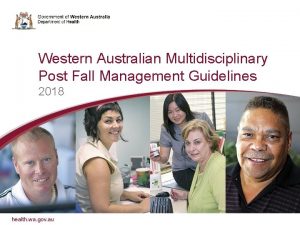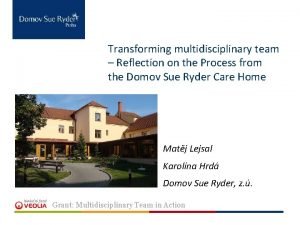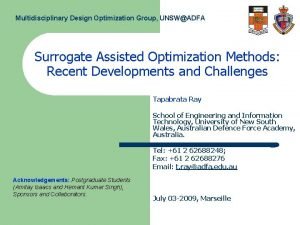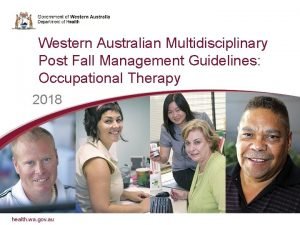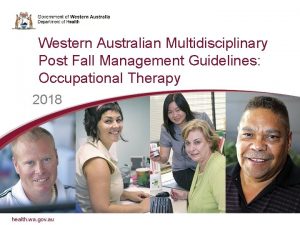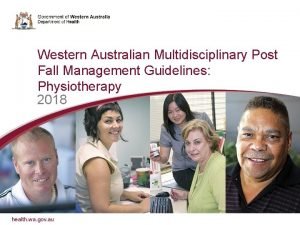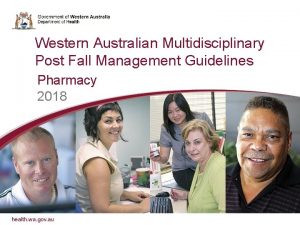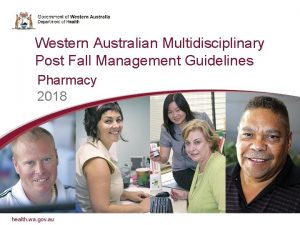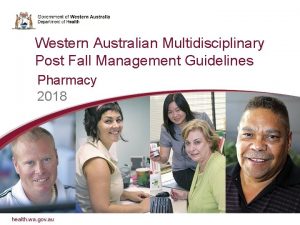Western Australian Multidisciplinary Post Fall Management Guidelines Occupational









- Slides: 9

Western Australian Multidisciplinary Post Fall Management Guidelines: Occupational Therapy 2018

Information about this Power. Point • • It provides a summary of the updated Post Fall Multidisciplinary Management Guidelines for Western Australian Health Care Settings 2018. It is designed to assist in the education of all health professionals involved in the care of a patient post fall. All health professionals involved in the care of a patient post fall should receive this information. It is a basic outline and contains only essential information. It can be adapted to suit your local area and staff. Refer to the complete guidelines. Supplementary notes are given below the slides. The application of local policy may indicate alternative actions or other policies to meet requirements. Please contact Falls. Management. WA@health. wa. gov. au if you have any questions/comments or feedback 2

Occupational Therapy Post Fall Management • Integral to the multidisciplinary management and care of patients who are at risk of falling, or who have fallen. • Completes an analysis of the inpatient fall, identifying the patients risk factors and contributing factors and providing targeted interventions related to those risk factors. Local Policy May Apply to Some of These Actions 3

Background • Guideline developed by Occupational Therapists within the Western Australian Multidisciplinary Post Fall Guideline Working Party 2018. • State-wide consultation of consumers, health professionals including aboriginal and untrained health care staff has occurred during the guideline development. • Highlights the OT core areas in relation to falls: üADLS üCognition üEnvironment 4

How to use in practice • Obtain referral. • OT to assess patient within two working days. • Complete Falls analysis and identify risk factors in areas of ADL, Cognition and Environment. • OT Interventions developed. (Appendix 2). • Document findings in patient health care record or use sticker ( Appendix 2 A). Local Policy May Apply to Some of These Actions 5

Appendix 2: Occupational Therapy Guideline Supporting Information Appendix 2. 1: Occupational therapy supporting information These guidelines direct your intervention following an inpatient fall. The role of the Occupational Therapist is to undertake an analysis of the fall and identify targeted interventions to address risks relevant to the three key Occupational Therapy areas of ADL (including the effects of vision), cognition, and environment. These risk factors and interventions are evidence-based and aim to reduce the risk of falls and harm from falls. 2. 1. 1. Occupational therapy activities of daily living Risk factors for falls • Decreased independence with Personal ADLS (PADL): Recommendations OT-Specific Interventions: Local Policy May Apply to Some of These Actions 6

Appendix 2. 2: Occupational Therapy sticker for patients health care record Local Policy May Apply to Some of These Actions 7

Points to remember • Focus on the current fall and how you can impact any further inpatient falls. • The intervention list in Appendix 2 is not an exhaustive list of interventions. • Consider the use of the sticker to be time efficient. • The post fall process should be familiar with all disciplines. 8

Summary • The role of Occupational Therapy is integral to the multidisciplinary management and care of patients who are at risk of falling, or who have fallen. • The guidelines have developed by the Occupational Therapists within the Western Australian Post Fall Guideline Working Party 2018 as evidenced based care for the patient post fall. • The guidelines are to be utilised in conjunction with the Post Fall Management Guidelines in Western Australian Healthcare Settings 2018. Contact Falls. Management@health. wa. gov. au for more information 9
 Post fall management guidelines
Post fall management guidelines Library and book mould removal
Library and book mould removal Fall prevention occupational therapy
Fall prevention occupational therapy Who was the leader of the franks
Who was the leader of the franks Scope of multidisciplinary nature of environmental studies
Scope of multidisciplinary nature of environmental studies Reflection on multidisciplinary team
Reflection on multidisciplinary team Multidisciplinary
Multidisciplinary Multidisciplinary vs interdisciplinary
Multidisciplinary vs interdisciplinary Multidisciplinary interdisciplinary and transdisciplinary
Multidisciplinary interdisciplinary and transdisciplinary Sunderlal bahuguna quotes
Sunderlal bahuguna quotes
